Category: Charles Caudrelier
Navigating the southern hemisphere
After setting sail from Ushant on Sunday 10 January at 01:33 UTC on the quest for the Jules Verne Trophy, the crew of the Maxi Edmond de Rothschild crossed the equator this Friday 15 January at 14h48’32” UTC, after 5 days 13 hours 14 minutes and 46 seconds at sea. Though this first passage time is a far cry from the outright record for this section, which has been held since 2019 by Spindrift Racing in a time of 4 days 19 hours 57 minutes, it has nevertheless enabled the sailors of Gitana Team to make the switch into the southern hemisphere with a lead of nearly six hours over the time set by Idec Sport.
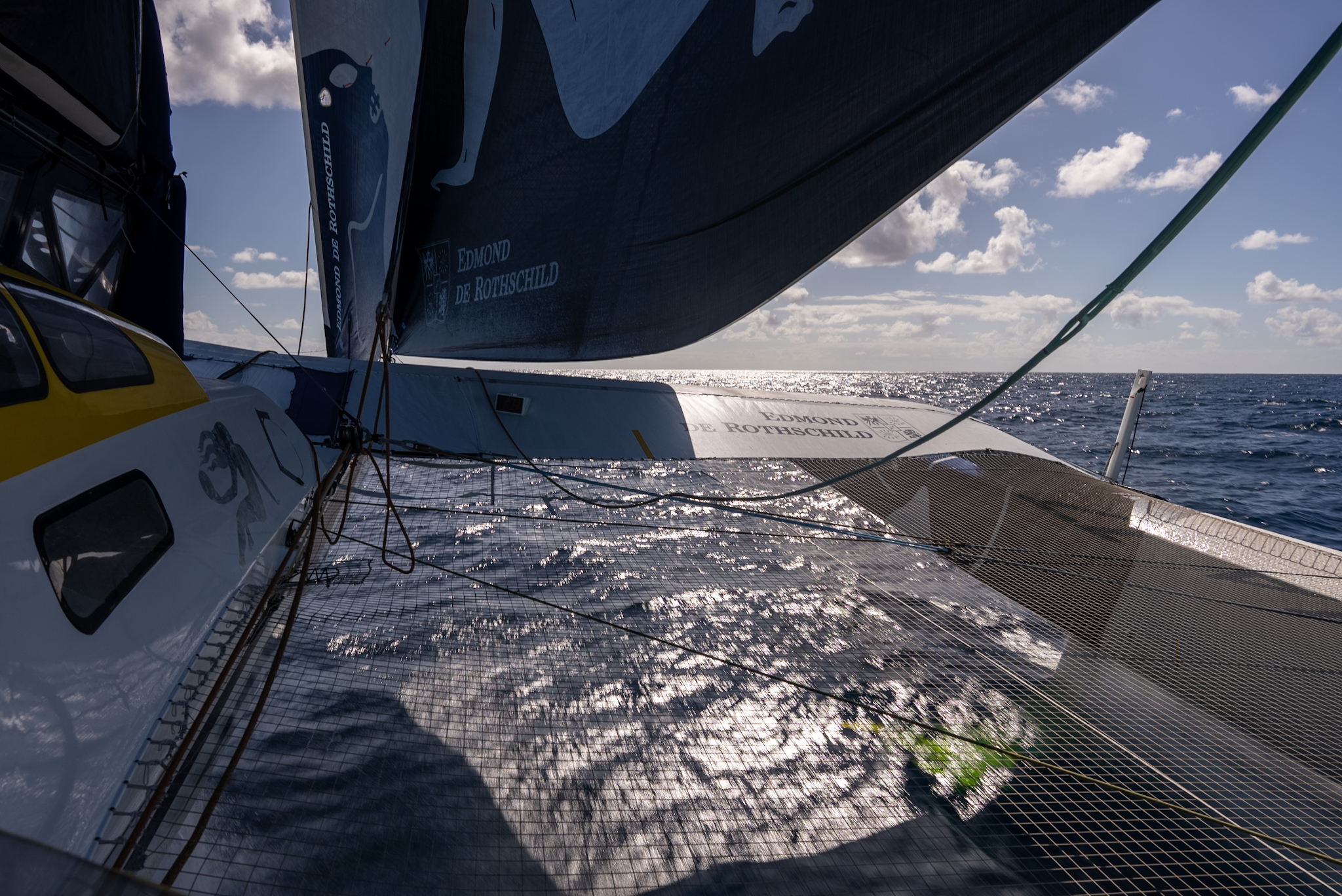
A very sticky doldrums!
This symbolic passage between the two hemispheres is certainly a moment for celebration for Franck Cammas, Charles Caudrelier and their four crew (David Boileau, Morgan Lagravière, Erwan Israël and Yann Riou), but above all they are happy to have rediscovered more favourable sailing conditions with which to do their steed justice. Indeed, the doldrums has been tough on the men of the flying maxi-trimaran. Finding herself with her wings clipped due to running out of breeze, the 32-metre giant struggled to extricate herself from the clutches of the infamous intertropical convergence zone. Throughout the course of the day yesterday and the following night, the crew had to simply learn to bide their time as they amassed multiple manoeuvres under a burning hot cuddy in a bid to make the most of the slightest gust and the tiniest cloud. This is evidenced by the navigation statistics from the past 24 hours: a little less than 260 miles covered at a speed of 10.8 knots with a VMG of just 6 knots… It proved to be interminable for a team of sailors striving to secure the round the world record under sail, who like nothing better than high-speed sailing.
However, aboard the boat, it’s with this philosophy that the crew traversed this zone, as Charles Caudrelier explains: “It wasn’t that hard in the sense that we always managed to keep the boat moving, even if it was extremely slow progress at times… but that enabled us to get some rest, because even though the start of our race wasn’t very violent, we were going fast so it’s never easy to sleep well. Right now, we’ve nicely recharged our batteries, we’ve found our sea legs and we’re right into the action. The last few calmer hours have also enabled us to do a thorough check of the boat, which is good because we won’t have a lot of opportunities to do that further down the track. We’re attacking the southern hemisphere with a boat in fantastic shape and that’s the best news! We’d certainly have liked a better passage time to the equator, it’s always nice to break a record, but with the doldrums you never know how things are going to play out. It wasn’t very wide but it was very painful.”
Welcome to the South Atlantic
Franck Cammas, Charles Caudrelier and their four crew launched off on the Jules Verne Trophy with a weather pattern in mind. Indeed, the transition into the South Atlantic contributed a great deal to their choice of weather window and the time they crossed the start line off Ushant. The idea was to get to a point offshore of Brazil when a sufficiently powerful front powering down to the Southern Ocean unleashed itself from the South American continent. And to benefit from better conditions for slipping along, which come with the guarantee of high speeds, you generally need to position yourself in front of this train of low-pressure. This whole sequence is the current target for the crew of the Maxi Edmond de Rothschild and their weather router, Marcel van Triest, if they are to stand a chance of securing a fine passage time to Cape Agulhas, in South Africa: “The time lost in the doldrums will not have a drastic effect since we’re arriving in the south at the right time, just as the models are being corroborated for hooking onto the right weather system. The problem that may be posed now is that we don’t have a lot of leeway. For the next four days, we’ll need to be quick and precise in our trajectory so that we don’t miss the train of low-pressure systems to the south of Rio,” underlined Charles Caudrelier.
An explanation of the timing
The lead and deficit, which appear on our cartography, are calculated at each ranking in terms of the distance to the goal. With the Maxi Edmond de Rothschild crossing the equator further over to the west than Idec Sport and hence further from the direct course (great circle route), she lamented a 16.6-mile deficit in relation to her virtual adversary. However, in terms of the actual time between Ushant and the line dividing the two hemispheres, the flying five-arrow maxi-trimaran was faster than that of Francis Joyon and his men. Five days 13 hours 14 minutes and 46 seconds for Gitana 17 compared with 5 days 18 hours and 57 minutes for Idec, which translates as a passage time 5 hours and 44 minutes quicker.
Within the hellish doldrums
Some 24 hours ago, the men of the Maxi Edmond de Rothschild plunged brutally from high-speed downwind conditions to close-hauled sluggish progress with no wind. Since then, the six sailors have tried everything to extricate themselves from the clutches of this very sticky, all-pervasive doldrums, performing multiple manœuvres and trimming their entire sail wardrobe. But nothing is working! The wind has vanished and with the exception of a few cooperative clouds, which are enabling them to make start-stop progress towards the exit, this passage across the intertropical convergence zone is turning into a long, hard battle. Fortunately, this is not the sailors’ first go at this and they are able to gain some sense of perspective in light of the thousands of miles that lie ahead of the bows of the flying maxi-trimaran. The long old day and sleepless night has cost them dearly. Credited with a 140-mile lead yesterday morning, the sailors of Gitana Team are kicking off their sixth day of the attempt with an 86-mile deficit at 07:00 UTC.
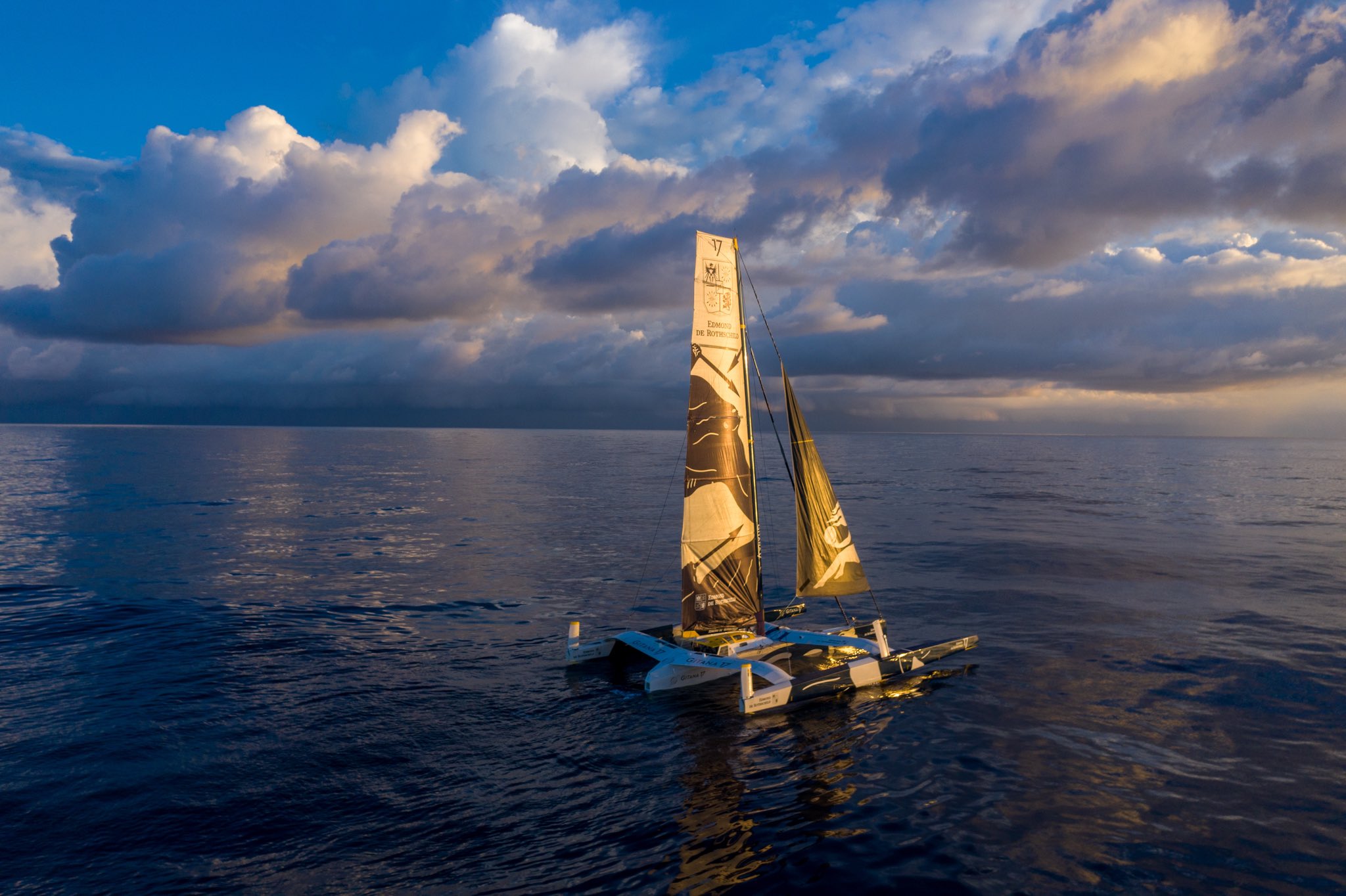
A different scenario for every passage through the doldrums
It is a given that on passing through the gates into this convergence zone between the two hemispheres, you’re entering into the unknown. From violent winds fleshed out by active squalls to an endless series of calm spells, anything goes here and nothing is set in stone. From one race to the next, the doldrums reserves a very different fate for the sailors traversing it, which is why it is so feared by sailors everywhere. Yesterday morning, upon brutally toppling into it at around 08:00 UTC, Franck Cammas, Charles Caudrelier and their crew did not imagine that they would spend 24 hours here, powerless against the lack of wind.
Aboard, despite the tension associated with this lack of speed and the time ticking away, the different watches have endeavoured to continue their routine of rotations to keep up the pace. This is no mean feat amidst the numerous manœuvres, which require all the crew to come up on deck, and the exhausting heat under the cuddy and in the central hull of the Maxi Edmond de Rothschild.
Casting one’s mind forward to the next stage of the round the world and taking the positives from the situation are doubtless the best way to begin this 6th day of the Jules Verne Trophy record attempt. The equator, still nearly 150 miles away on a direct course, should be behind them today at which point a very different navigation awaits in the SE’ly trade wind on a course towards the Southern Ocean.
Braking on the approach to the equator
On the fifth day of Gitana Team’s attempt to secure the Jules Verne Trophy, the miles gained over the record holder during the descent of the North Atlantic, have melted away to nothing. Going from a 140-mile lead this morning, the meter has slipped into the red late in the afternoon. The reason for this is that since the end of last night, the men on the Maxi Edmond de Rothschild have been ensnared in the doldrums and it’s the light airs version with slow progress, which has been reserved for them. Faced with these weather hazards, which are completely unpredictable in this intertropical convergence zone, the only option is patience. Aboard the latest of the Gitanas, these calmer times have been put to good use to do a complete check of the boat and recharge the batteries, despite the stifling heat, which has gatecrashed the insides of the five-arrow giant.
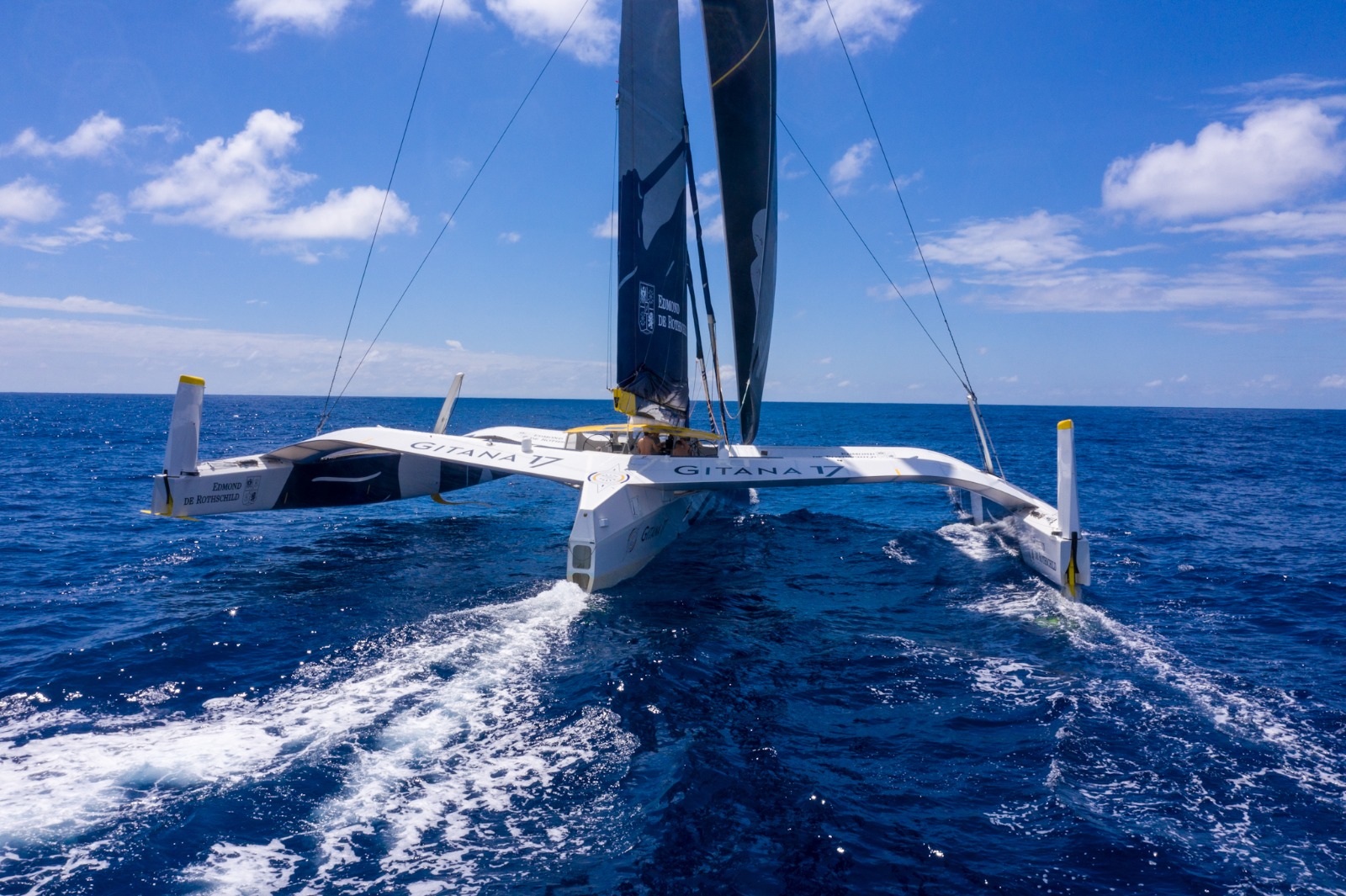
“A big curtain of a squall!”
At the end of last night, the entry into the doldrums was brutal for the six sailors on the Maxi Edmond de Rothschild. Morgan Lagravière, who was on watch during this express transition between the trade wind and the convergence zone, described the scene: “It came just as day broke and the half-light gradually became brighter. We began to see the first squalls appearing on the radar. We were only mildly suspicious but then the moment we fell under the influence of the squall, the wind picked up and we got nailed by a serious header and, fairly swiftly, we had to rush to the sheets to prevent the boat from heeling over too far! It rapidly became a case of action stations! We had to roll in the headsail, the large jib, so we could switch to a sail better suited to sailing close-hauled. It all happened in the blink of an eye. We didn’t have the time to ask any questions and a few minutes later we all had a good shower, making the most of the end of the squall!”
An exit this evening or overnight
Since this squall rolled through, the wind has vanished from the zone in question. And this is the case for miles around. As a result, the team aboard the blue flying maxi-trimaran have no other option than to just grin and bear it and try to exploit the slightest puff of air in the sails to free themselves from the clutches of the doldrums.
“We have very calm weather, clear skies and small cumulus, reminiscent of summer, not the colours synonymous with a classic doldrums. So for now, there are no black squalls and none of the usual wind. We still have 60/70 miles to go in the light airs before we discover the winds of the southern hemisphere so there’s still a very long way to go. We’d like to hook onto the wind that’s ahead of us, as the more miles we tick off now, the more they will multiply later, creating a concertina effect. Right now, we’re in the middle and it’s very, very calm weather. We’ll get all the possible sail area aloft to extricate ourselves”, admitted Franck Cammas this afternoon.
This 14 January won’t be one to remember with any fondness on this attempt, but aboard the boat, the six members of the crew know how to get things back in perspective and cast their minds forward to the next stage of the programme in the South Atlantic, which is still shaping up to be very interesting. Today, they have had to endure a great deal, but if we look in more detail at the route carved out by Idec Sport, the current holder of the trophy, it is tomorrow that their virtual adversary begins to stall…
The doldrums on today’s menu
Since passing offshore of Cape Verde yesterday morning, the Maxi Edmond de Rothschild has been slipping along at a fair old lick in the trade wind of the northern hemisphere, on a direct course to the equator. However, for the past few hours, the six sailors that make up her crew have been experiencing a slight change in weather pattern. In fact, at 6° North, the intertropical convergence zone is making its presence felt ahead of the bows of the 32-metre giant and with it comes a whole bunch of the weather hazards so renowned and dreaded by the sailors traversing the area. After four days at sea in this Jules Verne Trophy, Franck Cammas, Charles Caudrelier and their four crew are attacking the doldrums with a 143-mile lead over the current record.
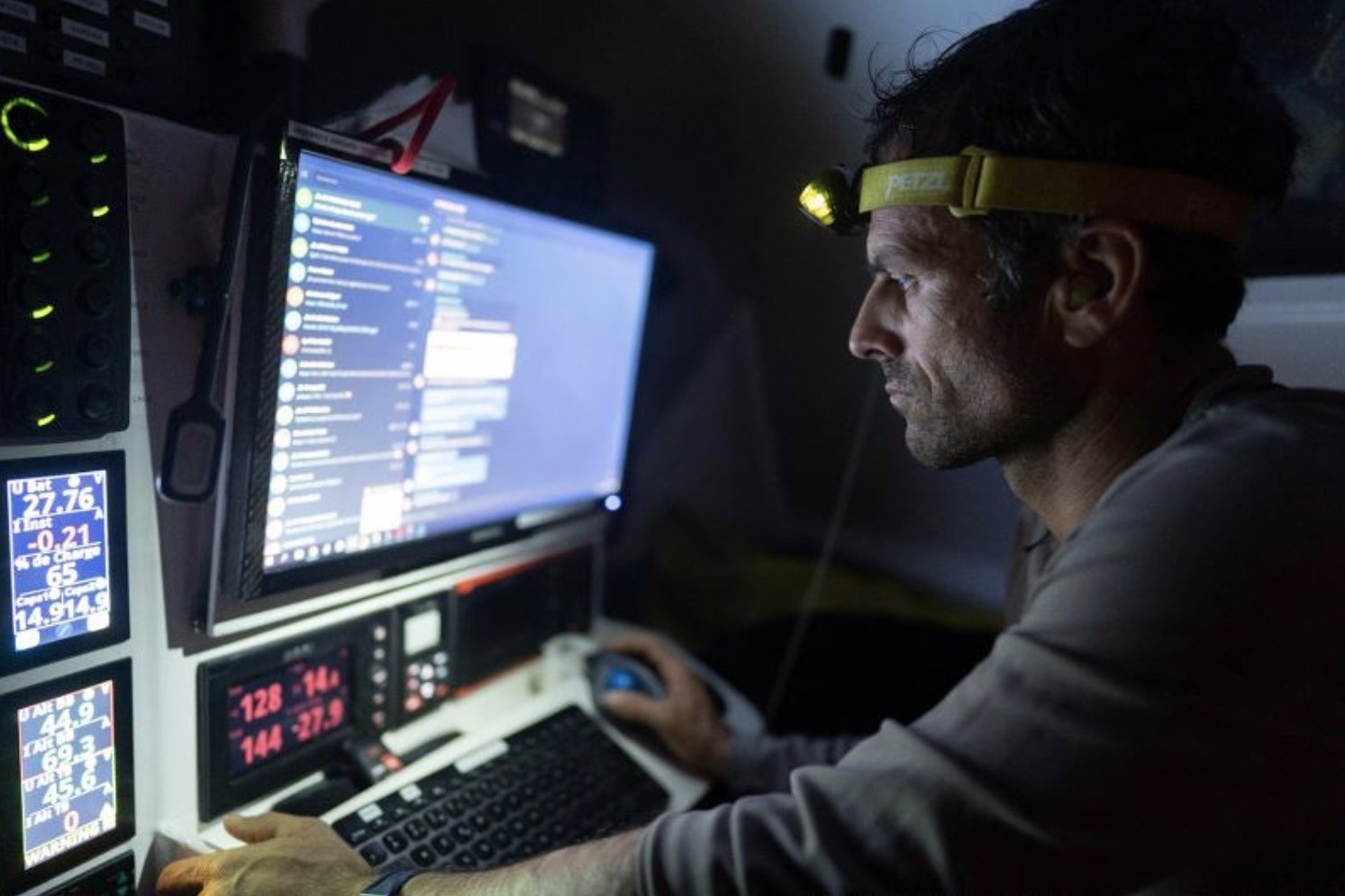
The hand of fate
Last night, before suffering the first effects of the doldrums, Yann Riou concocted a very vivid picture postcard of their high-speed passage in the trade wind. “There’s no doubt we’re under the tropics!” quips the crew’s onboard media man at the start. “All’s well aboard. Conditions over the past 24 hours have been fairly easy. I did a short watch yesterday evening and there was a whole procession of flying fish. They were passing onto the trampoline and under the trampoline. They were taking off at the bow and landing at the back of the boat. We can see sargassum too… The water temperature has increased considerably! So why am I talking to you about the water temperature? Because that’s what you can feel inside the boat. And that’s not a very nice aspect of it because the central hull is really very hot… a fairly muggy heat. It’s not always easy to rest and get off to sleep in these conditions. That said, it’s very pleasant on deck and well ventilated. Right now, we’re in little T-shirts and are currently making 35 knots, 37 even under autopilot. We’ve hardly used the autopilot since the start but it’s working well here. We’re making headway towards the doldrums and we’re keen to see what fate has in store for our passage. At this exact moment we’re making 38, 40 knots! It’s pitch black and cloudy and we have the radar on to keep watch and look at what’s going on ahead a little. We’regoing very fast and the sea has flattened out nicely enabling us to make the most of the boat’s true potential.”
Indeed, in the past 24 hours, the flying maxi-trimaran has been racking up an average speed of 32.5 knots, which equates to nearly 800 miles covered along the course. However, this Thursday 14 January won’t be coloured by the same pace. Though the environment continues to change in the ITCZ and it’s always difficult to predict the upcoming weather conditions, despite the quality of the forecasts and the expertise of the team’s weather router, Marcel van Triest, the name of the game is always the same for him. It’s all about finding the best possible passage through, namely the area where there is still some breeze, whilst targeting an exit point that’s not too far west so we maintain a favourable angle of attack to enter the southern hemisphere.
A first record possible?
The first intermediate record of this round the world, approved by the WSSRC, is that between Brest and the equator. Today and since 2019 it has been the property of the Swiss team of Spindrift Racing with a time of 4 days 19 hours and 57 minutes. With what seems like an active intertropical convergence zone still to negotiate, this reference time looks like a tough ask for the men of Gitana Team. However, with the doldrums you can’t be sure of anything so there’s always hope… To achieve that, Charles Caudrelier, Franck Cammas, David Boileau, Yann Riou, Erwan Israël and Morgan Lagravière would have to make the switch into the south and cross the virtual line between the two hemispheres before 21:30 UTC this evening!
Trade wind flight at last
The efforts deployed by the men of the Maxi Edmond de Rothschild since leaving Ushant on Sunday are bearing fruit on this fourth day of the record. To exploit the chosen weather window as best they can, Franck Cammas, Charles Caudrelier and their four crew have had to link together a series of gybes, extending the course which will lead them down towards the equator. Since this morning though, they’ve been making headway in the trade wind and have got nicely into the groove on port tack so as to exploit the true potential of the five-arrow flying maxi-trimaran. At 17:00 UTC, the latest of the Gitanas had again clawed back some miles in relation to her virtual adversary and boasted a lead of 115 miles.
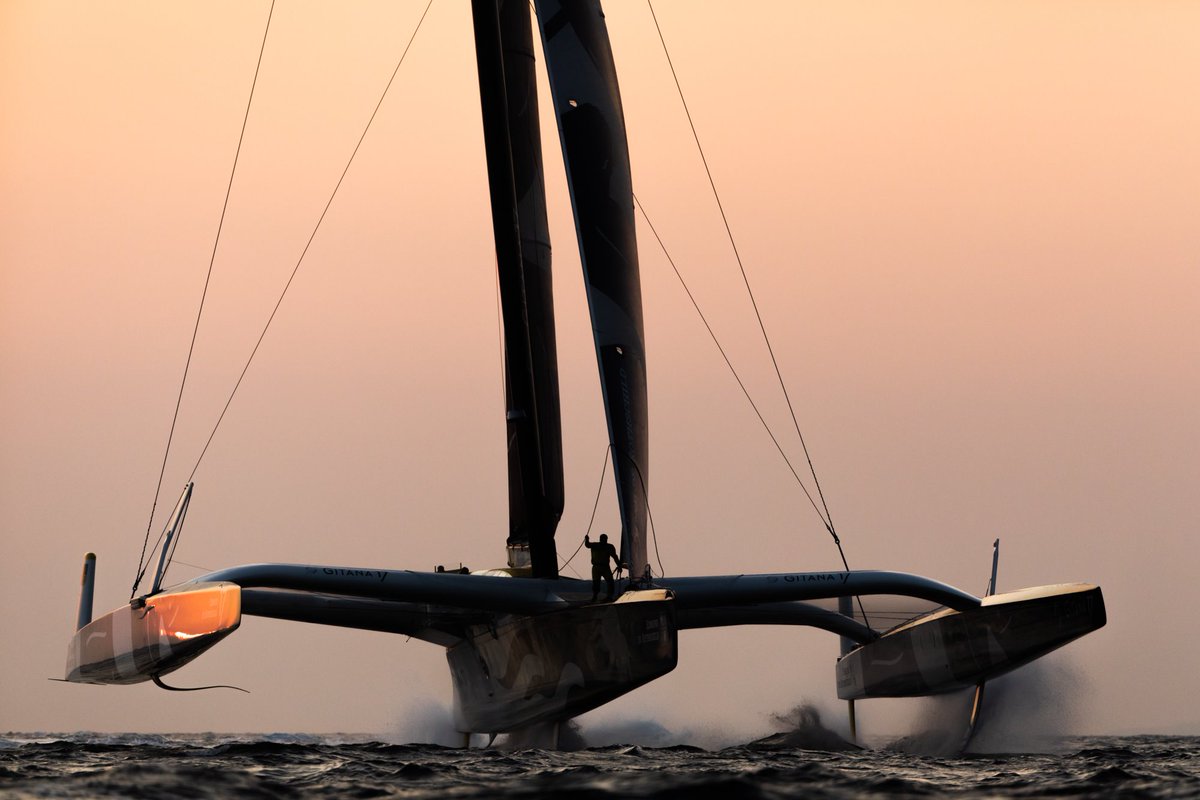
In the doldrums from tomorrow morning
Every passage through the doldrums is unique and like no other. Just hours before they take on the first of this Jules Verne Trophy, since the Maxi Edmond de Rothschild will likely feel the first signs of it at 6° North, Franck Cammas shared his impressions with us: “We’ve had a bit of a long transition between Madeira and the trade wind, but since last night we’ve finally made it into the trade wind system and we’re going to have a good 24 hours of calmer sailing. Late tonight, we’ll enter the doldrums, a quite complex zone where we’ll have to do some manoeuvring. We’ll need to be patient I think, as you can end up in some wind holes. Unfortunately, I reckon we’ll attack that section late tonight or even in the early hours of the following day. It’s always a bit better and easier to negotiate it during the day as you can see the clouds coming and you can anticipate their arrival a little.”
For now, the six men of Gitana Team are benefiting from a well-established NE’ly breeze in excess of 20 knots to pick up the pace. These conditions are particularly favourable for the 32-metre giant, which has managed to shake off the effects of the wind shadows created by the volcanic islands of Cape Verde and has since lengthened her stride. The average speed of 36.5 knots recorded in the last four hours bears witness to this.
After those 4 days, Franck Cammas, one of the skippers aboard the Maxi Edmond de Rothschild and David Boileau, boat captain and crew, reveal all about the change of mode. Indeed, in a matter of hours, the men tear themselves away from land and pull on their sailor’s garb. What is their experience and how do they deal with this switch from landlubber to sailor?
Franck Cammas : “Obviously the nights no longer resemble those on land”
“The transitions are always brutal, between the departure where you have your whole entourage around you on the dock and the moment where you find yourself at sea, in a crew, alone or forming a pair; it’s always pretty brutal. And then obviously the environment and the comfort we have on land and what we have aboard is diametrically opposite, so you have to get used to that. We’re quite aware of this aspect and know that the first few days are never the easiest. We await the coming days… Right now, three days out, we’re in the process of really getting into the ambiance and we feel increasingly at ease. On the one hand, there’s the rhythm of the watches, 24/7. Obviously, we no longer have the complete nights you can have on land. You have to get used to waking up quickly or in some urgency when you have to put in a manœuvre. You have to get used to sleeping during the day too, that’s an important element, and then there’s the environment, the noise, the motion, the ability to prepare something to eat… It’s a lot more complicated on the boat, especially during the first few hours where generally we don’t make proper meals… You have to get your head round all these things, for daily life and for your health, and get yourself sorted so you can endure 40 days. One thing for sure is that we won’t have the same rhythm as we do on land!”
David Boileau : “Hygiene is one of the major differences in terms of life on land”
“The fact that we spent the first night at sea before crossing the line off Ushant at 01:30 UTC gives us the impression that we set sail the day before. Ultimately, after just two days, you feel like you’ve already spent a lot of time at sea… Your ability to adapt aboard is of varying degrees of complexity depending on the conditions you encounter at sea. In this instance, we’ve had milder conditions at the start than on our first attempt and, on a personal level, I’ve immediately got into a good rhythm. I’ve got my sleep pattern sorted straightaway. I haven’t had a problem getting off to sleep or recuperating. I’ve immediately felt good and relaxed on the boat from the get-go.
I haven’t yet performed my ablutions since we set sail (laughs). Hygiene is one of the major differences in terms of life on land. We do what we can to stay clean, but you have to contend with the weather conditions and they dictate what you can do. At least I’m cleaning my teeth every day, which is something!”
A Cape Verdean sunrise
As envisaged by the weather forecasts, the NE’ly wind picked up last night to between 25 and 30 knots between the Canaries and Cape Verde. After a series of lively exchanges with their router Marcel van Triest, Franck Cammas and Charles Caudrelier had left the door open to a more direct passage between the islands, albeit on the proviso that that sun had already risen in order for them to thread their way through the heart of the archipelago. In the end, given their progress, it is with an option via the west that the crew will ultimately round Cape Verde this morning, leaving sufficient room to avoid the effects of the wind shadow created by the volcanic islands in the sails of the Maxi Edmond de Rothschild. Their lead over Francis Joyon’s record fluctuates every time the latest Gitana puts in a gybe or repositions herself to the west, but it has remained relatively stable at around 100 miles for several days.
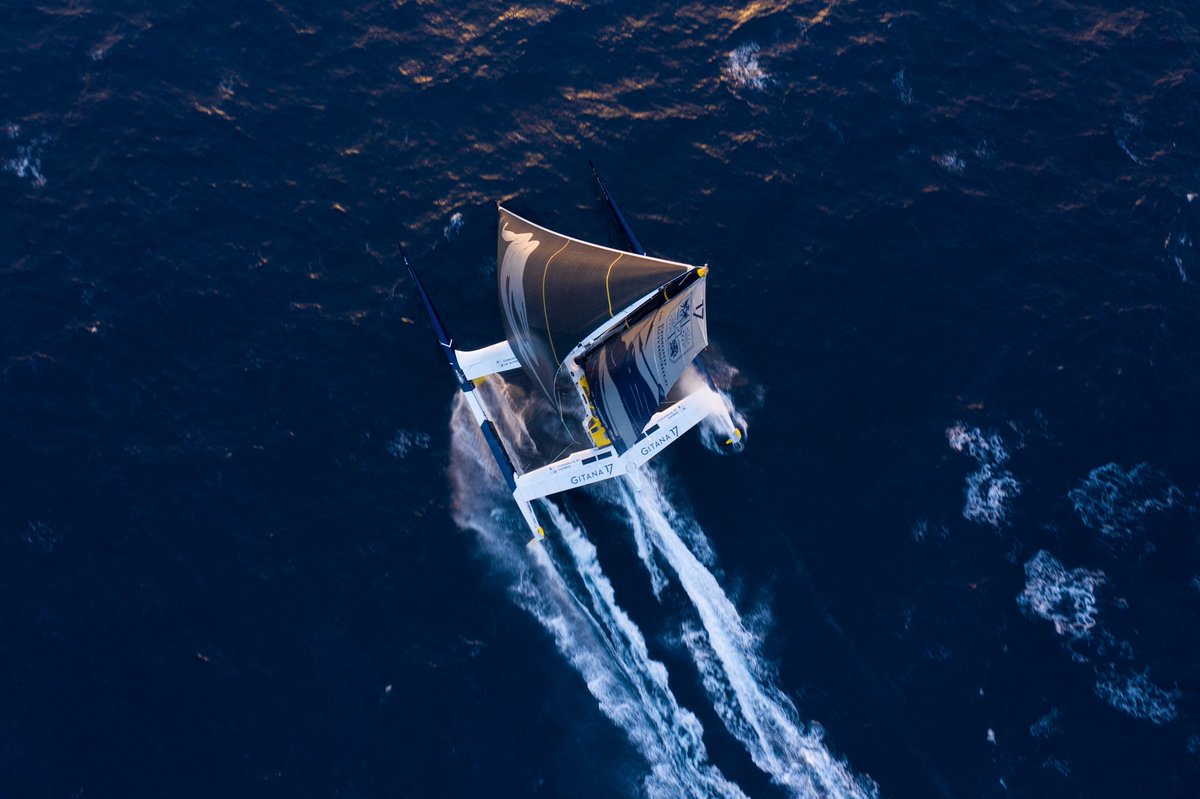
Favouring a more conservative trajectory
On the approach towards the Cape Verdean archipelago, it was tempting to shoot straight between the islands of São Vicente and São Nicolau to target a more direct route down to the equator. However, snaking your way between these volcanic islands is never a trivial matter, particularly with a 32-metre flying maxi-trimaran powered up at full speed. “This passage was debated but ultimately abandoned after assessing the potential gains and the risks. Amidst wind shadows, accelerations, fishermen and the latter’s fishing pots, it’s not easy sailing for boats like ours. The deal was finally sealed by our passage time because it’s still dark so we would have lacked visibility as the nights are pitch black at the moment”, explained Yann Riou in his night message.
The yoyoing miles
The decision to pass to the west of the archipelago has cost the crew of the Maxi Edmond de Rothschild two new gybes and with them the logical losses incurred in relation to their virtual adversary. Indeed, during her attempt in 2016-2017, on this long tack towards the equator, Idec benefited from a weather pattern that enabled her to stay on the same tack. The men of Gitana Team aren’t able to enjoy the same configuration or a such a straight trajectory. Overnight, their biggest lead amounted to 177 miles, a figure which had dropped back down to 90 miles at 07:00 UTC. However, there’s nothing abnormal about this situation since the slightest repositioning to the west equates to an almost negative VMG.
The positive message we can draw from this affair is that despite the numerous gybes racked up over the past two days, Franck Cammas, Charles Caudrelier and their four crew are still out in front and at the 07:00 UTC position report, the 32-metre giant was once again pointing her bows in the right direction on a course to the SSW.
At the gateway to the trade wind
Since setting sail off Ushant in the early hours of Sunday 10 January, at 01h 33′ 46” UTC, Franck Cammas, Charles Caudrelier and their four crew have been continuing their descent of the North Atlantic bound for the equator. Having covered nearly 2,000 miles in two and a half days, at an average speed of 31.4 knots, the men of the Maxi Edmond de Rothschild are nicely into the swing of things and, at the 17:00 UTC position report, had even treated themselves to a lead of 139 miles in relation to the record set by Francis Joyon. This third day of the record has been punctuated by a weather transition along the length of a ridge of high pressure associated with the Azores High and the six sailors have had to deal with some very variable winds, which are much too light for their taste, in order to gain headway to the south. However, rest assured that from tonight, there will be a drastic change of scene as the NE’ly breeze is set to flesh out as they approach Cape Verde.
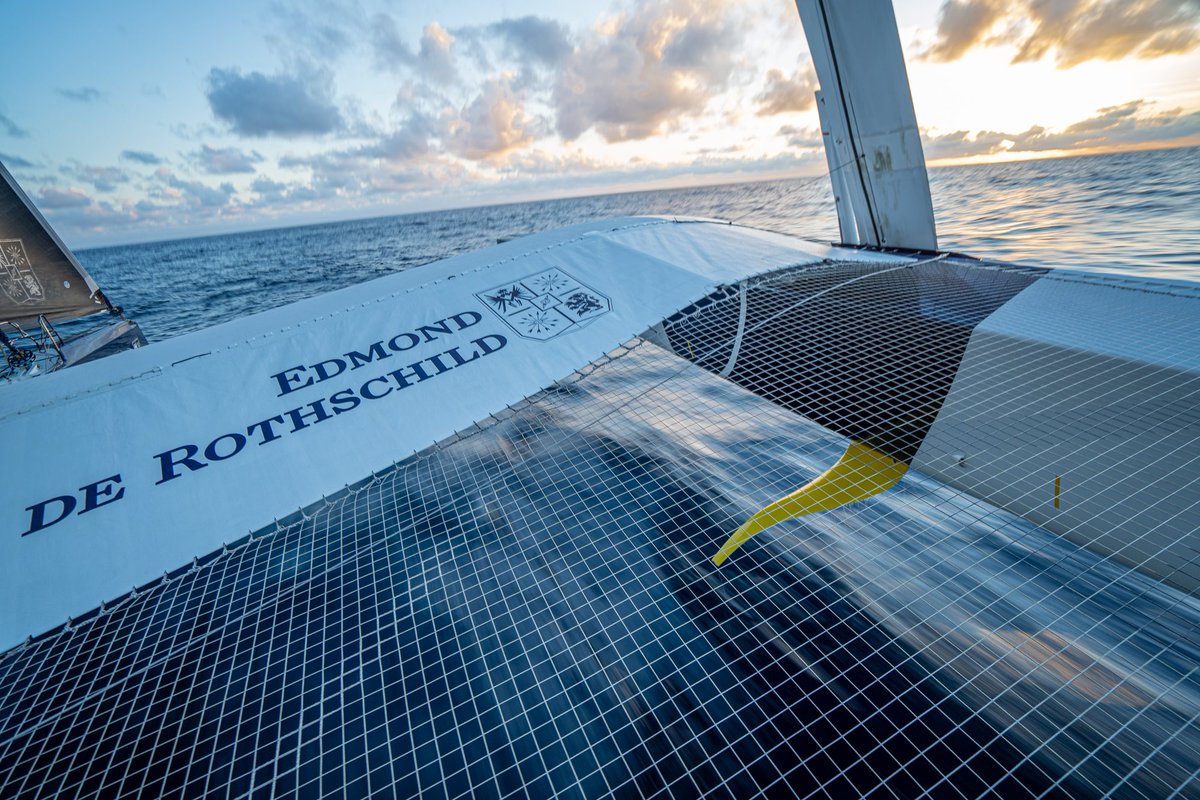
A transition zone bordering a ridge of high pressure
Stalling off the Canaries
After 48 hours at sea and nearly 1,700 miles covered since the start, the Maxi Edmond de Rothschild is offshore of the Canaries this morning. Making an average speed of nearly 32 knots since Ushant, the six sailors who make up her crew have been endeavouring to exploit every possible aspect of their weather window and are sparing no effort in the mission to get their 32-metre giant down to the equator, as evidenced by the string of gybes performed yesterday to get around Madeira. Though the wind is easing on the approach to the Spanish archipelago, the wind has dipped below 20 knots since last night and Franck Cammas, Charles Caudrelier and their four crew still have a slight lead in relation to the record, namely 117 miles according to the 07:00 UTC position report.

Escaping southwards
As indicated on the weather models, the ridge of high pressure is continuing its course eastwards and is gradually sprawling out in the wake of the latest Gitana. In constant contact with their onshore router, Marcel van Triest, the men of the Maxi Edmond de Rothschild have been utilising every possible variation in the wind since late yesterday in a bid to gain southing as quickly as possible, whilst conserving a trajectory over to the west to line themselves up for their descent towards the southern hemisphere. Though there is a strong temptation to favour a passage focused purely on speed and the ability to slip along over this section of the course, positioning is key since it is already colouring the point at which they pass through the doldrums and above all, in the short term, the angle at which the crew of Gitana Team will be able to hook up with the NE’ly trade wind.
For this third day of the record, the programme will focus on the negotiation of the wind shadow created by the Canaries which, like Madeira yesterday, is proving to be quite a task given how far it extends southwards, together with the management of the trajectory for the next ‘checkpoint’, that of the Cape Verde islands offshore of Mauritania.
Night message from Yann Riou
“Yesterday, we passed quite close to Porto Santo but as we rounded Madeira the visibility became blurred as the island was completely enveloped in cloud with a fair bit of stormy development. However, I did manage to complete my first drone flight, which I’ll make a point of processing so I can send it to you in the morning. In the last few hours, the wind has eased as we approach the Canaries. It feels paradoxical somehow after a rapid and fairly bracing start to the record, but this temporary calm is not unpleasant, especially when you’re getting some rest off watch. All in all though, we prefer it when we’re going fast and the boat is whistling. That’s what we’re here for after all!”
Into the Atlantic rhythm
At the 18:00 UTC position report this Monday, the Maxi Edmond de Rothschild had covered 1,313 miles over the ground since leaving Ushant on Sunday at 01:33 UTC. Posting an average speed over this distance of 32.7 knots, it is a clear indication that the crew of the 32-metre giant is already very much in tune with the fast pace required by a record like the Jules Verne Trophy. After a bracing phase during the passage around Cape Finisterre, where the sailors had to contend with a solid breeze of over 30 knots and chaotic seas, conditions were becoming calmer this Monday afternoon as they skirted the Portuguese archipelago of Madeira. Charles Caudrelier, Franck Cammas and their four crew currently have a 65-mile lead over the record.
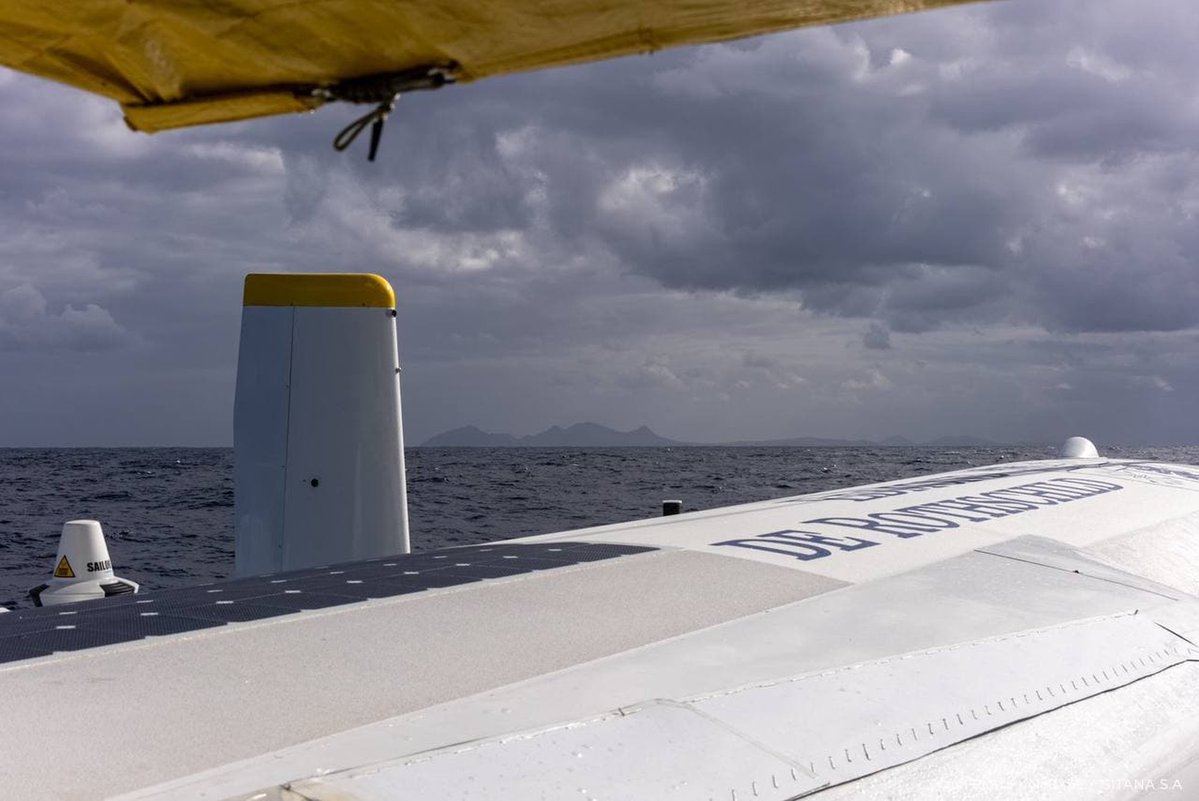
Finisterre’s teeth rattling conditions
As is always the case at sea, it’s all about finding a balance. In an ideal world you would try to gain southing so as not to get your wings burnt flying too close to the ridge of high pressure, but you also need to gain ground to the west so that further down the track you don’t fall under the influence of the wind shadow created by the Canaries and abeam of the Cape Verde archipelago.

